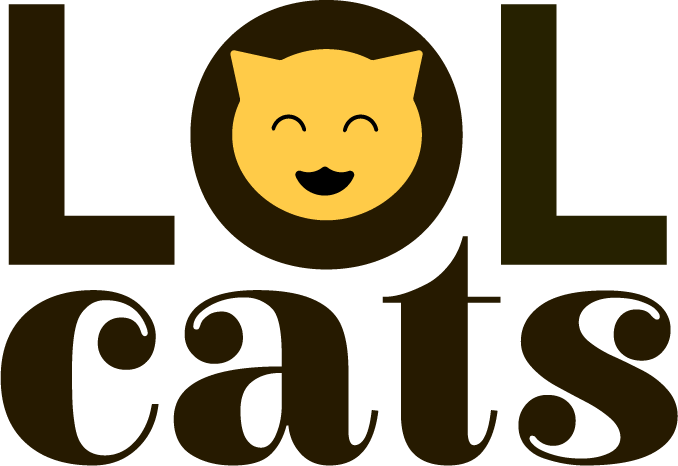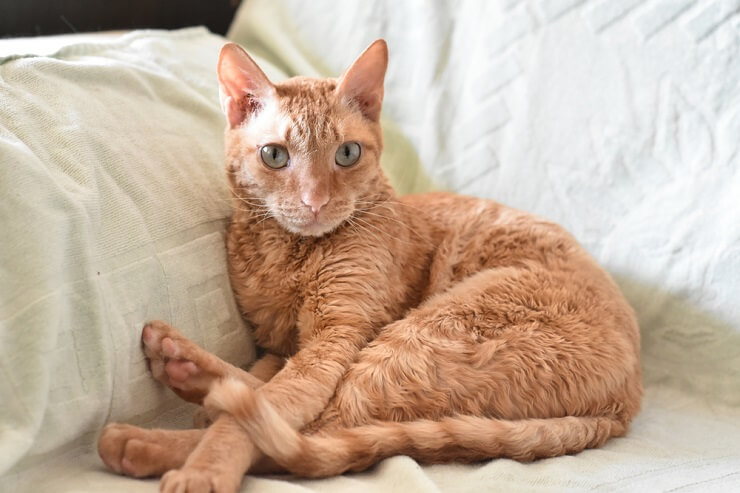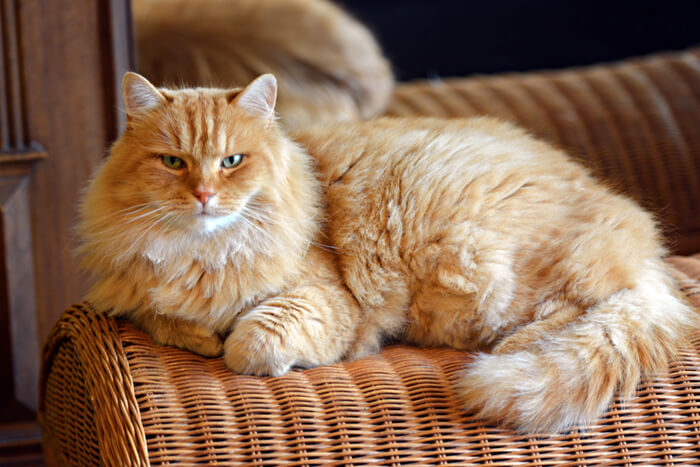4 Cat Breeds with Beautiful Curly Coats (With Pictures)
This page contains affiliate links. We may earn money or products from the companies mentioned in this post through our independently chosen links, which earn us a commission.
Do you have a cat with a curly coat or would you prefer one for a pet?
While some feline lovers can’t resist cats with stunning blue eyes, others are in love with furballs with fuzzy coats.
Curly-haired cats are unique and cute. They also make wonderful companions although they’re rarer compared to other cat breeds.
Notably, only four cat breeds are internationally recognized to have curly hair. But before we let you know which these fuzzy fluffballs are, let’s look at what makes a cat have curly hair.
How Do Cats Get Curly Hair?
The genetic variation which results in a cat’s soft curly or wavy hair is called rex mutation. This mutation alters the structure of a group of hairs and the cross-section of the individual hairs making them appear curly rather than straight.
A curly coat is scientifically referred to as a ‘rexed coat’. Rexed mutation is rare and it occurs spontaneously in a variety of animals.
Notably, the four known curly-haired cat breeds belong to the ‘rex’ class due to the natural genetic mutation that causes them to have wavy or curly hair. The curly hair genetic variation is also found in other mammals such as rats, cats, horses, rabbits and dogs.
Four Curly-Haired Cat Breeds

There are only four curly-haired cat breeds recognized by The Cat Fancier’s Association and The International Cat Association.
They include:
- Selkirk Rex
- LaPerm
- Devon Rex
- Cornish Rex
Other breeds with a curly coat such as the German Rex, Tennessee Rex, Ural Rex, Tasman Rex, and Skookum are yet to be internationally recognized as curly-haired cat breeds.
Some cats with curled hairs are said to be hypoallergenic as they shed very minimally or may not shed at all. Their dead hairs are tangled in their coats and can only be removed by brushing. That’s why curly-haired cats are more popular among pet lovers with allergic reactions.
Let’s now look at each of the four curly-haired cat breeds so you can make a more informed choice on which one of them suits you best.
#1 Selkirk Rex

- Temperament: Outgoing, affectionate and social
- Coat Colors: Black, white, silver, grey, cream, red, tan, and chocolate, with different shadings and patterns
- Weight: 6 -16 pounds
- Shedding: Moderate
The Selkirk Rex cat’s origin can be traced to Montana.
This cat breed’s physical features include a muscular body, round head, big eyes, curly whiskers and big, sturdy limbs. Her soft curly hair which covers the entire body is more pronounced at the tail and neck. The Selkirk Rex cat comes in short and long hair versions.
Notably, some Selkirk Rex kittens are born with a curly coat while others come in a straight coat. The curly hair on this furball’s coat appears at birth, straightens then reappears when the cat is between 8-10 months. This cat’s fuzzy silky coat matures when the cat is 2 years old.
Selkirk Rex is a medium-sized feline who appears larger due to her voluminous curly coat. Her curly coat is dense, soft, loose, and woolly. These furballs are the waviest cat breeds. Compared to other curly-haired cat breeds such as the Cornish and Devon Rex, the Selkirk Rex coat is denser and longer. Some of the Selkirk Rex cats have tight curls while others have long ringlets depending on whether they’re short or long-haired.
The first type of Selkirk Rex was a rescue cat called Miss Depesto. She was named after a character in the popular TV show, “Moonlighting”. Miss Depesto nicknamed “Poodle Cat” was born in 1987 in an animal shelter. Out of the six kittens born in the shelter, only one had a luscious curly coat. Miss Depesto is thought to have inherited the mutated rex gene from her mother who had slightly wavy hair.
A local Persian breeder, Jeri Newman adopted Miss Depesto and started breeding more curly-haired kittens. Jeri Newman named this breed in honor of his stepfather, Selkirk and added Rex due to genetic variation resulting in soft curly fur.
When Jeri Newman bred Miss Depesto with a black Persian cat, she gave birth to a litter of six kittens, three had a curly coat and the other three had a normal coat. Selkirk Rex was officially declared a breed in 2012 by Scientists at the University of Veterinary Medicine.
The Selkirk Rex is a playful and curious furball that will follow you around the house. They are also very affectionate and social felines that don’t like being left alone for long hours. This means that you need to provide this cat with plenty of physical and mental stimulation.
The Selkirk Rex’s outgoing nature makes her a great pet for families with plenty of free time to spare. They are also very patient and will get along well with children and other pets in the house. These cats can also learn new tricks easily.
The Selkirk Rex coat requires to be regularly combed to keep the hair from tangling.
Fun fact: The Selkirk Rex is the only cat breed named after a person.
#2 LaPerm

- Lifespan: 10 -15 years
- Temperament: Energetic, friendly and affectionate
- Coat Colors: Different shadings and patterns including black, white, grey, red, blue, silver, chocolate, cream, fawn, cinnamon, lavender, tabby and tortoiseshell
- Weight: 5 -10 pounds
- Shedding: Low
LaPerm is a natural breed with a medium-sized muscular body, big ears, long legs, a long tail and a wavy coat that resembles the human perm hairstyle. The LaPerm’s coat is a blend of springy curls and soft waves. The hair ringlets are tight on the neck, stomach, and ears but a bit loose on the rest of the body. LaPerm comes in both long and short coat varieties and the coats come in different shades and patterns.
LaPerm’s origin can be traced back to a farm in Dalles, Oregon. In 1982, one of the farm cats gave birth to a bald kitten whose coat later became soft and curly. The kitten later gave birth to unusual-looking litters with curly hairs who were the first LaPerm cats. A breeding program was later developed in 1992 in which curly-haired cats on the farm were allowed to breed freely.
Notably, LaPerm cats are rare and expensive. This is a slow-maturing cat breed that takes 2 to 3 years to reach maturity. LaPerm kittens are born either bald or with short hairs which tend to disappear after birth and then reappear when the kitten attains 10 months. These medium-sized cats have luscious wavy or loose corkscrew-like curly coats that don’t shed much.
These sweet and easy-going fluffballs love attention. They are also super affectionate and won’t turn down a chance to spend time with their favorite humans. If you’re a LaPerm cat parent, you’ll notice that she often follows you around just to be close to you.
Also, these felines are great climbers so we advise that you get your LaPerm a cat tree to keep her off your shelves. They are also smart felines that can easily be trained in multiple tricks.
#3 Devon Rex
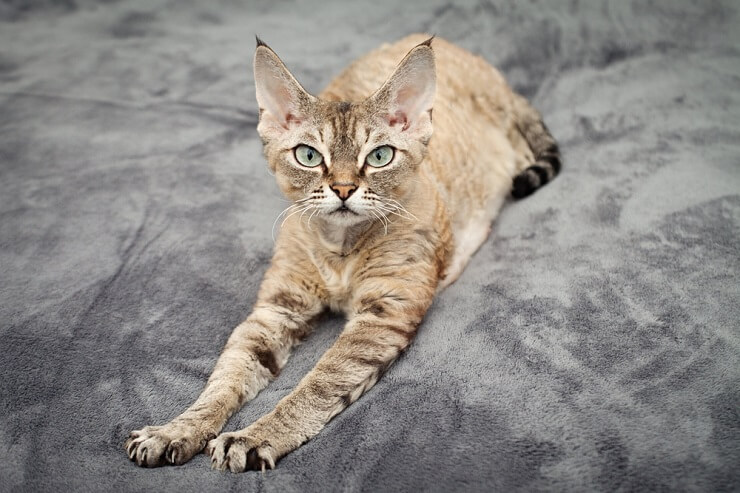
- Lifespan: 9 -13 years
- Temperament: Sociable, affectionate, bold and mischievous
- Coat Colors: Black, blue, white, red, cream, chocolate, lavender, fawn, and cinnamon, plus a range of different shadings and patterns
- Weight: 5 -10 pounds
- Shedding: Low
The Devon Rex is one of the smallest cat breeds. She has a slim body with large ears, long legs, and a curly tail. This cat has an unusual yet irresistible alien-like appearance due to her slender body and big bat-like ears. This cat’s coat appears wavy rather than curly.
The first Devon Rex kitten was named Kirlee. He was born in the 1960s when a curly-haired male cat and a white and tortoiseshell female cat sired a litter of kittens. Initially, Kirlee was thought to be a Cornish Rex cat but it was later discovered that his beautiful curly coat was due to a different gene mutation. Breeding Kirlee with other cat breeds resulted in curly-haired kittens which led to the establishment of a breeding program in Devon, UK named Devon Rex.
Devon Rex is a very active and curious cat. This cat’s active nature means there is never a dull moment with her. She will jump, climb, and follow you around just to get a glimpse of what you’re doing. Ensure you provide your Devon Rex with plenty of interaction and toys to keep her occupied.
The Devon Rex’s playful nature makes this feline a great pet for families with children. This cat also enjoys spending time with other pets. They are also intelligent cats that can learn many tricks quickly even at a young age.
These cats shed very little making them suitable for families with allergies. Their curly coat is very delicate, and shouldn’t be groomed often since over-grooming makes the hair break.
#4 Cornish Rex
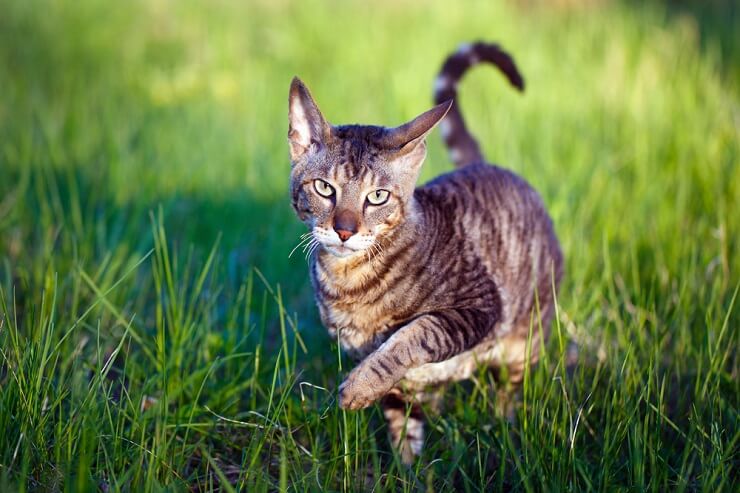
- Lifespan: 9-15 years
- Temperament: Sociable, friendly, bold and athletic
- Coat Colors: Black, white, red, blue, silver, cream, chocolate, lavender, tabby, and smoke, plus a range of different shadings and patterns
- Weight: 5-10 pounds
- Shedding: Low
The Cornish Rex cat first appeared in 1950 in a barn in Cornwall. A little kitten at the farm called Kallibunker was born with a cute curly coat among other straight-haired kittens. This curly-haired kitten was discovered and adopted by Rex rabbits breeder, Nina Ennismore. The breed was later recognized in 1957.
Notably, the Cornish Rex is more popular in the US than in her native country since the first pair of this cat breed was imported to the US in 1957.
The Cornish Rex has a slender athletic body with a narrow face, large ears, a long tail and an extremely short curly coat. This cat’s whiskers are also curly making her have a distinctive appearance.
The Cornish Rex shares most of her physical traits with the Devon Rex.
However, the Cornish Rex has an extremely soft short curly coat because she only has the down layer of hair. Cornish Rex lacks guard and awn layers on her coat, making her coat to be quite thin. On touch, this feline’s coat feels silky and warm. Her fine soft undercoat is also very thin, about 1cm long.
The Cornish Rex is an athletic cat that can run and play endlessly. She likes playing games such as fetch, racing other pets, going for long walks, climbing and jumping. They are also intelligent cats that can easily adapt to new environments. Cornish Rex cats also tend to be quite vocal when they’re craving attention.
Further, these felines are people-oriented and love to be in a household with lots of company and plenty of play. They get along well with children and other pets and they can easily be trained in new tricks.
Since the Cornish Rex kitties have extremely short hair and some are hairless, they’re always trying to keep warm. Ensure you provide your Cornish Rex cat with enough blankets and you also keep her in warm and dry indoor conditions.
How To Take Care Of Your Curly-haired Cat
When it comes to taking care of your curly-haired fluffball the most important thing to remember is how to take care of their coat. Curly-haired cat breeds coats are built differently and will require special care.
Ensure you:
Brush and comb their coat– Unlike other cats, most curly-haired cats including the LaPerm and Selkirk Rex require their coats to be brushed at least twice a week. This helps prevent matting. Ensure you use specific combs that are made to brush the pretty dense and curly coats of your cat. When it comes to the Cornish Rex and Devon Rex, regular brushing isn’t necessary as these two have looser hair. Over-grooming in these two cats can also lead to bald spots. So, take it slow when it comes to brushing their coat.
Bath them often – Curly-haired cat breeds coats often become oily because the coats don’t absorb oil from their skin. To keep their coats grease-free, bathe your furball often. Ensure you use safe and gentle products to keep your cat’s skin nourished and their coat shiny.
